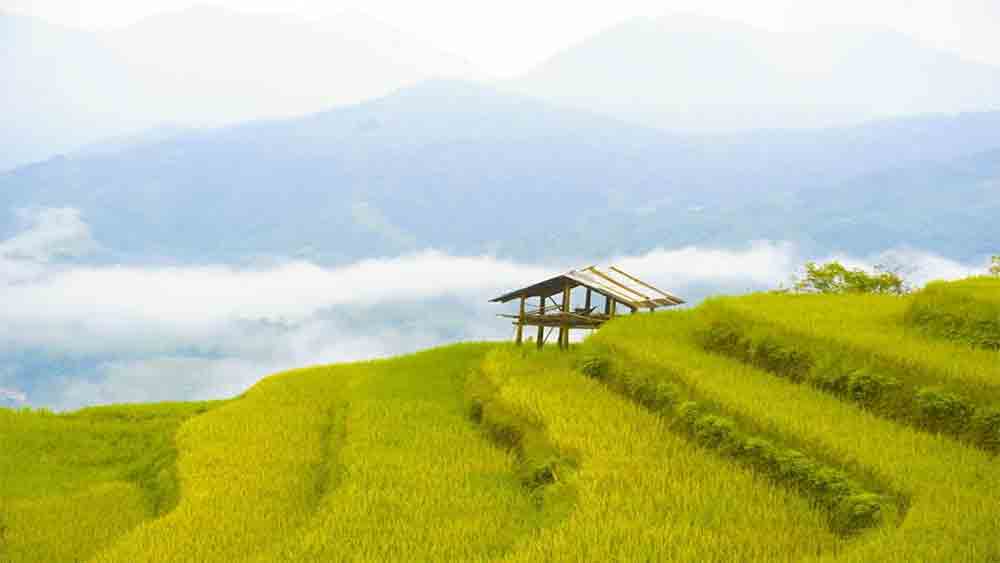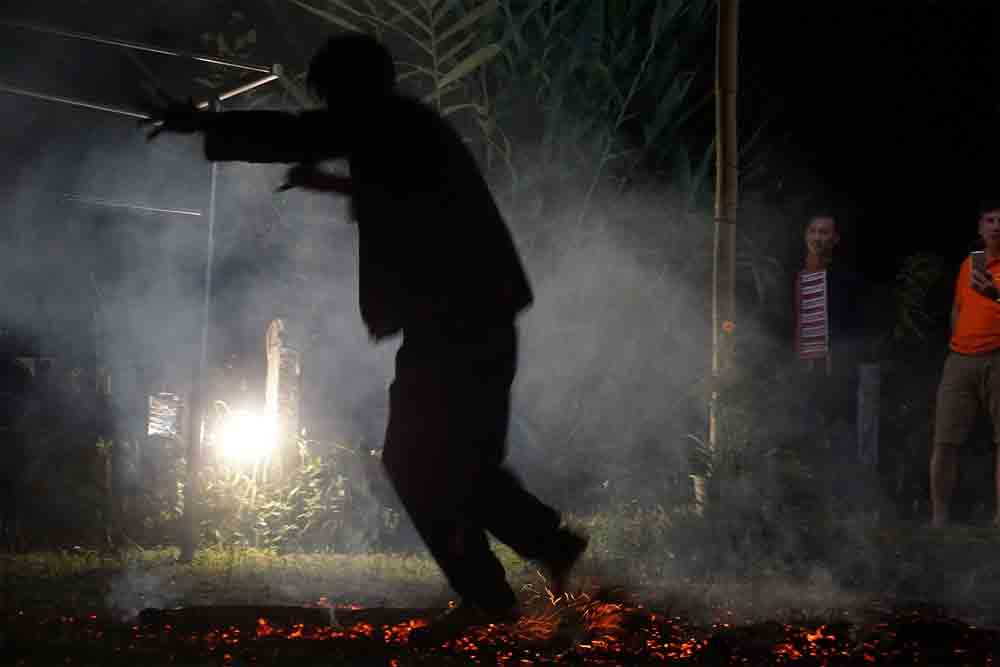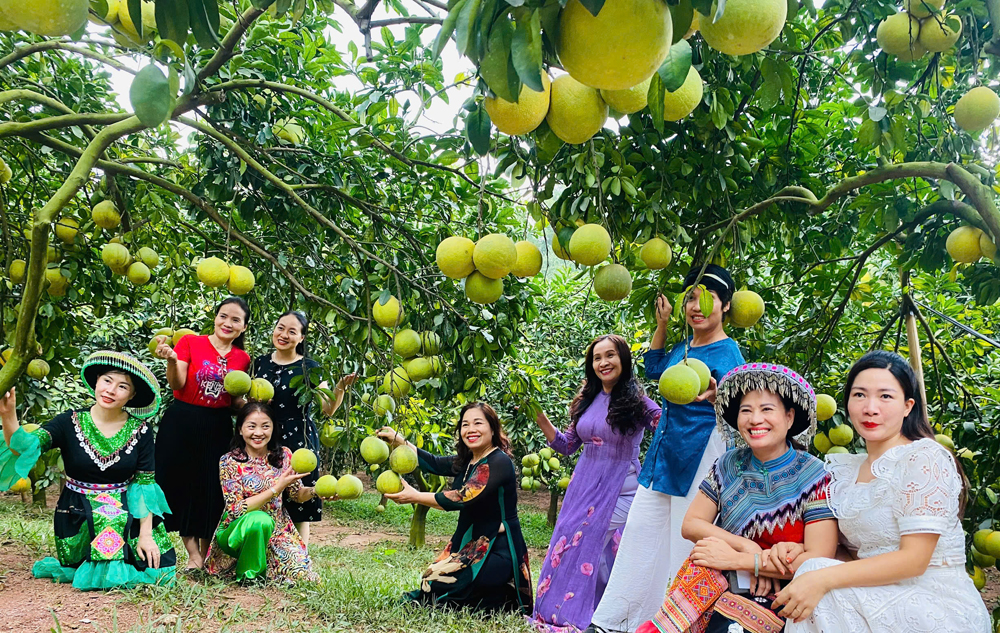Golden rice season in northern Vietnam village Nam Hong
Propped against the mountain at an altitude of 800 m, Nam Hong Village encompasses 38 red Dao ethnic households. The village in Thong Nguyen Commune, Hoang Su Phi District is located 33 km from National Route 2 and 77 km from Ha Giang Town, capital of Ha Giang Province.
 |
|
Rice terraced fields in Nam Hong Village. |
A few years ago, Nam Hong villagers relied mainly on agriculture, tea cultivation, and fish farming to survive. Today, the Nam Hong community-based tourism village has become a leading draw in Hoang Su Phi District.
The first evening was a memorable one, after a hearty dinner of northern highlands specialties like boar, junglefowl, vegetables, and fragrant corn wine, I participated in the Nam Hong mid-autumn festival.
In the glow of campfire, I was unable to tear my eyes away from the supple and graceful moves of red Dao dancers. After a spiritual ceremony, barefooted red Dao men danced on burning coal.
This is a red Dao ritual that traditionally takes place in the Lunar New Year festival to thank the Fire Deity for warmth, safety, prosperity, and a good harvest, and for chasing away ghosts, devils, and diseases. Nowadays, the dance is performed regularly for tourists. That night, I fell into a deep, rejuvenating sleep.
Typically, rice harvesting is divided into four parts: bailing out water and catching fish, reaping, stacking, and threshing. That morning, I woke up very early to follow my tour guide Kinh to the fields.
From Hoang Su Phi Bungalow, I tightly held onto a bucket whilst chasing after Kinh up vast terraced fields. The paddies were yellow and ripe with droopy panicles ready to be harvested.
The arresting landscape brought about a light and tranquil feeling. I deeply inhaled the Highlands’ crisp pure air. Here’s to a new day.
Kinh’s rice field lay near the Horseshoe Hill. After a short trek, we arrived at the paddies. Kinh and his wife first released and directed the water in their rice field to others nearby. With a skilled hand, Kinh detected and caught large and robust fish swiftly swimming around rice plant roots and placed them in a bucket.
To ensure the fish are in the healthiest state when caught, locals release them into paddy fields after sowing at the end of April and beginning of May. In September and October when rice fields ripen, the fish reach full maturity. Locals then catch and bring them home.
Since the fish develop in a natural state, bred without fertilizer and around rice plants, they are organic and fresh. A gastronomical must-try when visiting Nam Hong is fish freshly caught from paddy fields paired with entirely clean, safe rice.
Foreign tourists visiting Nam Hong also excitedly rolled up their sleeves and waded through the field to hunt carp. Excitement and laughter resonated across the fields.
A week passed by since our fishing mission, with the fields now teeming with toiling Nam Hong locals. That morning, I woke early and with my sickle joined villagers for the harvest.
The way Nam Hong locals reap rice is very unique, severing half the rice stalk instead of cutting from the root, then placing those halves back onto reaped plants. Every harvest, locals form a ‘V’ shape with the plants to prevent panicles from dropping. Three days later, they head back out to the fields to harvest and thresh rice crops that have dried.
Right then and there, elation rushed through me as I felt like I belonged to this captivating ethnic community, participating in ordinary daily activities that perhaps I would never get a chance to enjoy again.
Locals here don’t thresh rice crops at paddies. After the crop has dried, they use a red fabric string to gather it into bouquets and piles for transport to a communal shanty. The climb from the fields down to the shanty is arduous since the ground is uneven and the bearer has to bow, maintain their balance, straighten their legs and manage a heavy pile of rice crops on their back. Beads of sweat quickly gathered on the farmers’ head as they firmly moved forward, the familiar look of perseverance flashing on their faces.
 |
|
A barefooted red Dao man danced on burning coal. |
After successfully transporting the thresher to the communal house, they began the threshing process and collected the final product into sacks. That harvest Kinh’s family collected in total 20 hefty sacks of rice, bringing a huge delighted grin to everyone’s face.
The red Dao community has a tradition that whichever household harvests that day has to host the village for lunch and dinner. Thus, that evening all the villagers convened at the harvester’s place to feast and celebrate.
In the afternoon sunshine of the following days, I strolled around emptied paddy fields in my trusty honeycomb rubber sandals and watched red Dao locals revel in buffalo wrestling matches.
If possible, I fell even more deeply in love with the land and its people. When harvest season came to an end, it was also my time to conclude my northern highlands adventure and return to Ho Chi Minh City.
If one gets infatuated with a region, it must be due to the intense love and appreciation one harbors for its people, animals, and scenery.
Source: VnExpress
 Bắc giang
Bắc giang
















Reader's comments (0)